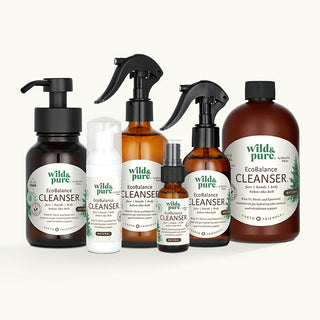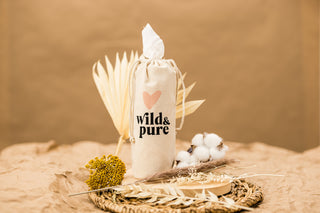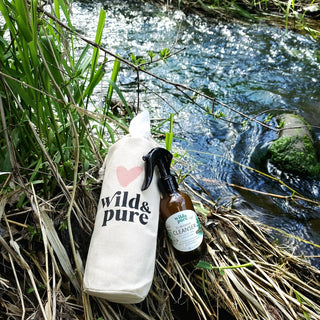Wet wipes are bad for babies’ and adults’ urogenital and rectal tissue (all that down there), healthy human bacteria, and our planet. In fact, our initial reason for developing EcoBalance Cleanser® was to design an effective, safe dry-wipe system for use in everyone, everywhere. We tested over 20 different dry-wipe brands and came up with two of our favorites that earned a spot in our store!
4 Reasons to use a dry disposable wipe with EcoBalance Cleanser instead of grabbing that wet wipe:
- Commercial wet wipes are thin and overly saturated. They can’t absorb much so you use a lot each time. They are difficult to individually separate out what you need, and messy as well (yuk).
- Plastic containers and wipe ingredients can be harmful. Wipes stored in plastics may leach toxic chemicals into the wipes, and many wipes have plastic fibers IN THEM. Similar plastics in personal care products have high enough carcinogenic benzenes and phthalates to increase blood levels in users (>80% higher chemicals)! Plastic microfibers and formaldehyde are not uncommon in wipes, and many wipes have “potentially allergenic ingredients” (such as glycerin, phenoxyethanol, citric acid, EDTA, sorbic acid, aloe vera, tocopherol/Vit E derivatives, polyethylene glycol derivatives, glyceryl stearate, sodium citrate). The plastic fibers and chemicals in wet wipes kill marine life, which absorb them from wastewater. And with wet-wipe use, 4% of the wetting solution transfers to the baby’s or individual’s skin during use. People with a wet wipe allergy have 15-fold more genital and rectal inflammation and irritation. Ingredients matter, especially for sensitive folks! Sadly, wipes are considered “cosmetics” and don’t require FDA approval. Most have undergone little testing, with rare scientific tracking of their risk.
- Products that are wet (like wet wipes) grow bacteria unless they contain preservatives and/or chemicals that limit bacterial growth. This is true even for “mild” sounding chemicals (like citric acid), shown to damage tissues and healthy bacteria. Using wet wipes many times a day can mean wiping with ingredients that change the body’s balance causing chronic inflammation and infection.
- Globally, we use BILLIONS of wet wipes every year for baby and personal care. These end up in the ocean, streams, and landfills, as well as clogging our septic and wastewater systems. (See how Wild & Pure is preventing plastic pollution.) In studies, over half the marine life near wastewater processing sites have microplastics and chemicals from wet wipes in their bodies, and the more contamination the fewer marine life that could survive. Wet wipes are bad for babies, adults, the environment, and our healthy microbiome.
Wet wipe use will change over time, there is just too much wrong with them for our personal and planet’s continued health. It doesn’t matter if they are flushable or not, each type of wet wipe has its drawbacks for health and safety.
We can all help lead the way in adopting safer cleansing systems for our families! As part of this effort, we tested many different dry wipes to find the best. Here are the two that worked best for our family and that we chose to stock in our store based on:
- Superb functionality = ability to clean most messes with 1 wipe. Careful folding and spraying of the dry wipe with EcoBalance Cleanser can give multiple passes at cleaning with a single wipe, while keeping you clean too.
- Non-irritating softness, coupled with strength – allowing rinsing out and reuse after gentle use.
- Design features that support our core values for global sustainability and urogenital and rectal safety.
Nest Design 100% GOTS certified organic, unbleached wipes. These compostable, smooth wipes were chosen for one of our grandchildren with very sensitive skin. In fact, diaper changing now including a final spritz of EcoBalance Cleanser has become a favorite time versus the battle that can occur with kids who have chronic irritation and inflammation. We love this unbleached soft cotton. Bleaching of personal care items adds extra processing and chemicals. We use these for house cleaning as they outlast paper towels and work great for glass cleaning.
Nest Designs includes sustainable designs developed by family members and moms looking to fill a need for safer products. The GOTS organic cotton used in this dry wipe is low impact on the environment, hypoallergenic, and comfy. These wipes are made overseas, using hand-picked partners, based on quality, craftsmanship, and employee well-being.
Wild & Pure Dry Wipes These large waffle-patterned wipes are made in the USA from 50% repurposed cotton clothing scrap, and 50% OEKO-TEX unbleached USA grown cotton. They stand up well to washing and reuse a few times. They are compostable. We love the canvas carrying bag that fits in a water bottle pouch of a backpack, and that can be refilled. No plastic packaging!
Visit our store to buy these fabulous dry wipes! And when you buy an On-the-Go Pack in April you'll get to try mini versions of both the Nest and Wild & Pure dry wipes!
Refs:
Water Res 2020 Sep 1;182:116021.
Sci Total Environ 2021 Aug 25;784:147144.
Environ Sci Pollut Res Int 2018 Jul;25(20):20268-20279.
Environ Pollut 2020 Sep;264:114577.
Dermatitis May/Jun 2019;30(3):207-212.
Food Chem Toxicol 2017 Aug;106(Pt A):107-113.
Dermatitis Nov/Dec 2017;28(6):353-359.
Dermatitis Jan/Feb 2017;28(1):64-69.
Journal of Women’s Health Jan 2020; 29: 65-73



